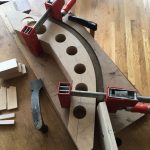We may receive a commission when you use our affiliate links. However, this does not impact our recommendations.
We released a video on YouTube yesterday all about nails. Christopher Schwarz presented a short lesson on the various types of nails available and why we might use them in different applications. To continue the conversation, I thought I’d pull together some of Chris’s posts on nails from his years of blogging on the subject. Check out what I found and leave a comment about your experience with nails in your furniture projects.
1. “What types of nails should I buy? And what sizes? Here are the nails that I stock in my shop and what they are good for.”
2. In fact, in pre-1850 America, it was common to burn dwellings that were to be destroyed in order to collect the nails from the ashes. If the nails were simply pulled from the building, workers could damage them.
3. Here are some of the things that can go wrong and how I deal with them.
4. Cut nails also will split your work if you use a nail size that is just too big for the boards at hand. And that was my problem today.
5. The following figures are for 10d nails (3″ long) and expressed in pounds of holding power per inch of penetration.
6. Cut nails hold like crazy and look quite nice in traditional work. And we are not the first people to think this.
7. Anyone who has been working wood long enough has struggled with the problem of filling nail holes.
8. Nails will bend to accommodate wood movement. Screws won’t bend.
Here are some supplies and tools we find essential in our everyday work around the shop. We may receive a commission from sales referred by our links; however, we have carefully selected these products for their usefulness and quality.









As one of the other magazines pointed out a few years ago, the distaste for nails goes back to when carpentry and joinery were separate (and sometimes competing) guilds, each having their own “mysteries” and having some legal protection for their specialties (similar to patent protection today). According to that article, only jointers were allowed to use techniques such as dovetails or mortise and tenon to secure pieces without additional pins and fasteners, or had the training to know how to allow for wood movement, and they could charge more for these elegant solutions. Carpenters could and did produce equivalent pieces of furniture, mailing the boards together instead and trusting that the nails would flex enough to allow wood movement…. So it was really a matter of fine furniture versus practical (and less expensive) furniture, just as it often is today, and the customer’s taste and budget (and the skills of the craftsman) would drive the market one way or the other.
If that’s true, then both approaches are historically accurate, it’s just a matter of which party of that history you want to reproduce. And of course new pieces can do whatever makes sense for your project.
The best tool or technique is the one that is available and produce the desired results.
Just remember: while screwdrivers make bad hammers, hammers make worse screwdrivers. Don’t ask how I know this.